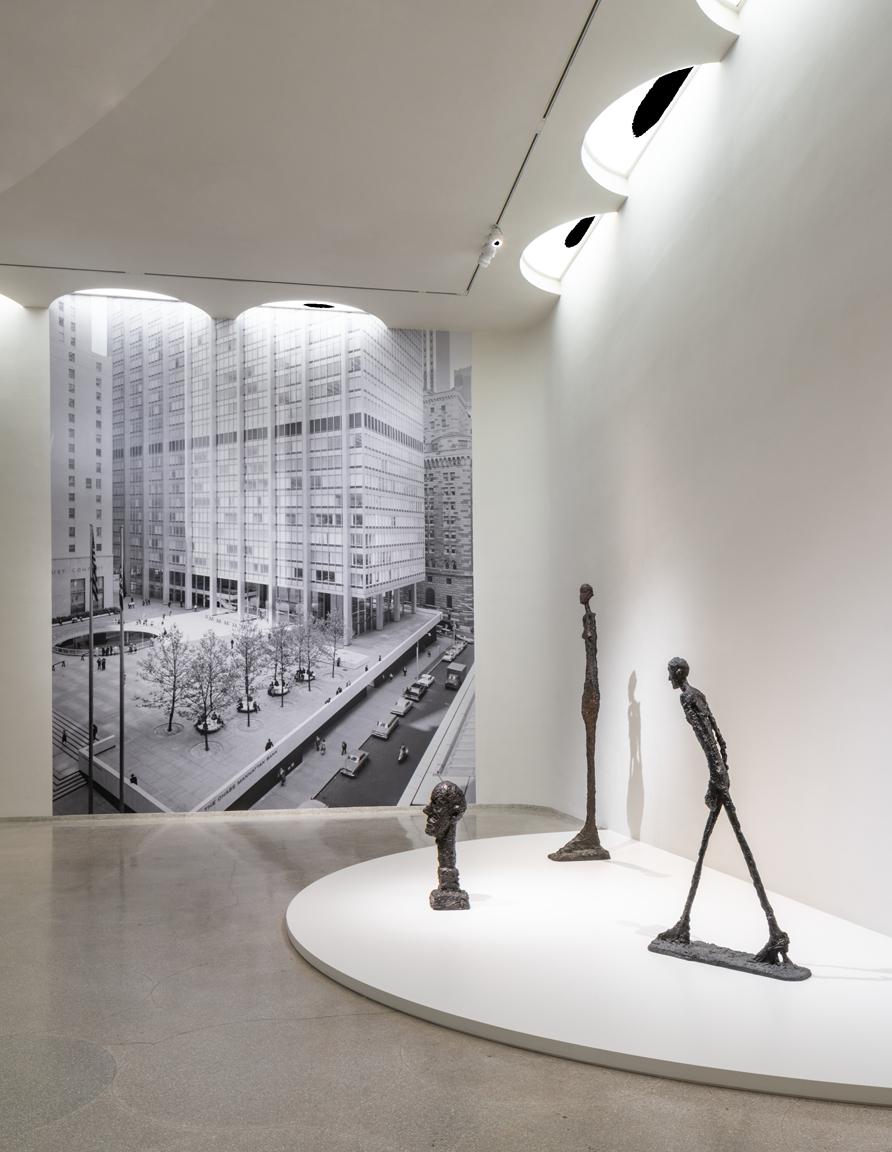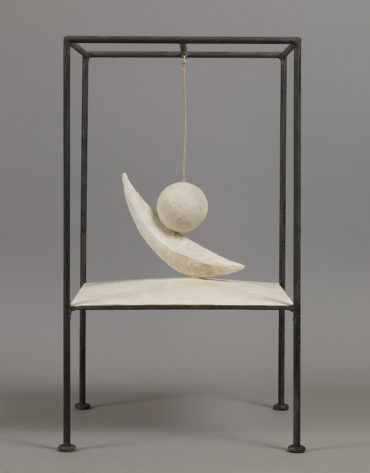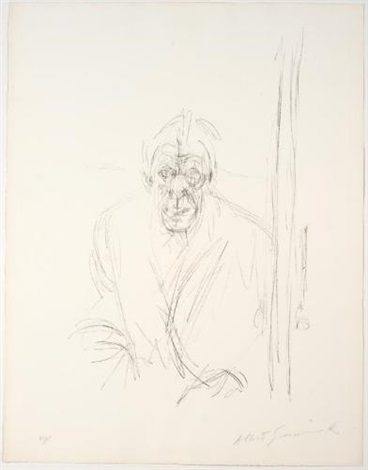At age seventeen, Alberto Giacometti could draw anything. The son of a post-impressionist painter in Italian Switzerland, he had a happy childhood, provided with the resources and education that make a talented boy a prodigy. A self-portrait he made in 1918 portrays a confident young man, posture straight, pen in hand. His penetrating gaze meets the gaze of the viewer. His brows are alert and almost symmetrical, lips parsed, and his hairline is delineated sharply against a broad forehead. Clear and tight are the contour lines he has drawn along the edge of his jacket, hair, and cheek. Between the angular fold of his collar and the elevated turn of his head, he has drawn himself as a master.
Decades later, he would recount to Andre Parinaud that at that age, the world appeared to him whole. In his youth, he experienced no separation between himself and what he saw, which he rendered with ease.
Then something happened. By Giacometti’s account, 1920 was the year the world began to appear stranger, more complex. He was in Rome, and a female friend had agreed to pose for him all winter as he sculpted a bust. At the end of those six months,19-year-old Alberto threw what he’d made in the trash. He could not grasp the head in its unity. He felt incapable of rendering what he saw. The contour lines had cracked open.
For young Giacometti, the collapse of what he thought he knew marked the beginning of an artistic career defined by astonishment. The visible world ceased to be a pretext for him to exercise his mastery and increasingly became a great mystery that eluded his understanding. In interviews, the complexity of the visible world is a source of frustration to Giacometti, who would bemoan his failure to render a head or a figure as it literally appeared to him. Yet his expressions of failure are tempered by an equal dose of hope, provided by the adventure of observing human beings, whose visible existence he never ceased to marvel at.
My own astonishment at Giacometti’s sculptures and paintings was renewed at his retrospective at the Guggenheim, curated by Megan Fontanella and Catherine Grenier, on view through September 12. Winding up the museum rotunda are seemingly endless variations on what would become, after around 1940, his mature themes. There are portraits of wide-eyed figures, their upper bodies foregrounded by swaths of gray in front of skeletal rooms. There are sculptures of walking men and standing women reduced to symbols of themselves, their figures shrouded in emptiness. The gazes in many of these sculptures, each two steadfast eyes looking at the the viewer, is still present as it was in the early self-portrait. But the figures themselves appear less substantive. As in his mature drawings where each stroke gives form to the white of the page, the surface of each figure is reduced in such a way to draw attention to the emptiness that surrounds them. Some of the most delicious moments of the sculptures I found to be at the edges of the jagged bronze or plaster bodies; the light between an arm and a torso like a resistant wax pushing away ink.

Installation view: Giacometti, Solomon R. Guggenheim Museum, New York, June 8–September 12, 2018. Photo: David Heald © Solomon R. Guggenheim Foundation, 2018.
By the time Giacometti committed for good to work from life in 1945, France was coming to terms with the loss of life and a shifting national identity in the wake of World War II. The grounds of existence felt unstable. While Giacometti’s mature work is not explicitly a response to the ravages of war, he acknowledged its role in shifting his perception of human beings.
There was, on one hand, the “danger of disappearance.” Some of the earliest figurative sculptures that he created, just after the start of World War II, depict minuscule figures secured to heavy plinths. In one on view at the Guggenheim, titled “City Square,” spindly male figures walk around – one female figure stands – upon a wide platform which, owing to its width, creates distance between them. Giacometti recounted that during this time the only way he could conceivably portray people as he saw them would be to make them small, as if he was seeing them from afar.
The positive condition of that “danger of disappearance” was, as Giacometti expressed often and with gusto, an expansion of the unknown, which rendered his vision of the reality all the more astonishing. Speaking to Parinaud in the 1960s, Giacometti recounted: “Before the war, I had the impression that things were stable. Today, not at all. The world amazes me more and more each day.”
This amazement is reflected with particular force in the wide-eyed looks of his portrait busts of and paintings – of his frequent sitters, his brother Diego and his partner Annette, as well as the numerous friends, lovers, and academics who could spare several days of being exhaustively observed in his studio off the Boulevard Montparnasse. A 1953 oil portrait of Diego at the exhibition portrays a seated man of dark gray color in front of a network of black lines delineating the space of a room. His figure brought forward by an aura of lighter charcoal scribbles around him. The volume of his chest, head and hands is denoted by glints of white. Vertical movements—in the length of his head, a central line between his clasped hands, and elongated tic marks for eyes, ground him in place. Diego’s form pulsates with the activity of intersecting lines, yet he appears very still. What “danger of disappearance” is suggested by Giacometti’s hollow rendering of the room behind Diego is abated by his arresting stare. That stare seems to mirror Giacometti’s own.
In Giacometti’s variations on “Standing Woman” the gaze appears as solid and fixed as the triangular weights for feet that secure them to the earth. Analogously to the seclusion of the sitters in Giacometti’s portraits, “Standing Woman” appears devoid of a context except that of the expanse of empty space evoked in proportion to the narrow figure.
The isolation of the figure in space is just one of the ways in which Giacometti’s nearly ten-year experiments in surrealist sculpture reverberate in his later work. Rewind to 1930, and Giacometti was working in the same studio on the Boulevard Montparnasse. Still perhaps reeling from that episode with the bust, he was convinced of the impossibility of rendering appearances. Instead, he committed himself to producing objects which, he said, “appeared to my mind in a finished state.” The goal was minimal interference of the structure as it had first appeared as a mental image, and so Giacometti avoided any trace of his own hand in each piece’s construction. Andre Breton introduced himself to Giacometti after noticing “Suspended Ball” in an exhibition in 1930, thus inviting him, if for a brief period, into his Surrealist tribe.
On view at the Guggenheim, “Suspended Ball,” consists of a marble ball that hangs from a cubic iron frame above a crescent-moon shaped sliver which is seated on a slightly elevated plane. At the base of the ball is a slit into which the crescent shape just barely grazes from the 45-degree angle at which it rests. Ambiguously sexual, the shapes appear frozen in a continuum of movement, hovering in a state of impotent potential.

Alberto Giacometti, Suspended Ball (Boule suspendue), 1930–31. Plaster, painted metal, and string, 60.6 x 35.6 x 36.1 cm. Fondation Giacometti, Paris© 2018 Alberto Giacometti Estate/Licensed by VAGA and ARS, New York.
In reference to Breton, Rosalind Krauss defined the surreal as a projection in real space that is “like a waking dream – a fragment of real space altered, because it is created by the desire of the dreamer” yet, she continues, “appears to him simultaneously as something independent of his own will, something he merely happened upon by chance.” It’s an appropriate description of “Suspended Ball” which consists of actual objects in real space arrested in space according to some unnamable, unconscious desire.
The correspondence of Krauss’s description to Giacometti’s later, figurative work is also revealing. Giacometti’s portraits and figures are the products of vision, not mental projection, yet the subjects of his sculptures and paintings were like his surrealist works in as much as they reveal something essential in how they were constructed in his mind. Like a surrealist “fragment of real space altered” Giacometti isolates that which, in his vision of reality, was capable of revealing forces and patterns that undergird the realm of appearances. Strolling through Paris many years after his surrealist heyday, Giacometti came upon a dog, in whose sullen appearance he saw himself. In his sculpture of the animal – a final treat of the Guggenheim show – it strides like one of the walking men on a flat plinth, alone as if in a dream.
In one of the last self-portrait drawings that he completed, in 1965, Giacometti depicts himself with open eyes and a mouth slightly agape. The straight-angled self-assurance of his youth is long gone. Instead are arched, inward-leaning shoulders which rise into a head. Curved dashes accumulate into darker crevices denoting the volume of a face that stares intently back.
The edges of the figure’s upper body are denoted in faint strokes that open to the light of the page. The top of his head is indicated by gestural touches and his chest is a criss-cross of angled dashes. Giacometti depicts himself as less substantial than he did in the drawing he made at seventeen. Instead, he has given weight to the space that encases his figure. His pencil strokes illuminate the empty whites.
Jean Genet put it well, calling Giacometti’s mature drawings “infinitely precious objects.” He writes, “The strokes are there only to give form and solidity to the whites. Look closely: it is not the stroke which is elegant, it’s the white space contained by it. It is not the stroke which is full, it is the white.”
In a 1963 interview with Andre Parinaud, Giacometti remarked upon the positive condition of his assumed failures to represent appearances. The unknown had expanded, and with it his astonishment at the visible world:
“The more I work, the more I see differently, that is to say, everything grows greater day by day, it becomes more and more unknown, more and more beautiful.”
Giacometti will be on view until September 12, 2018 at the Guggenheim Museum in New York. The exhibition is curated by Megan Fontanella, Curator, Modern Art and Provenance, Solomon R. Guggenheim Museum, and Catherine Grenier, Director, The Fondation Giacometti.
—Kate Butler, Education Intern, The Drawing Center


